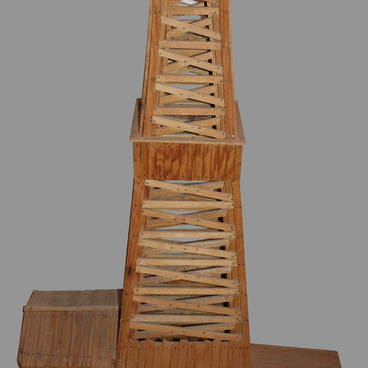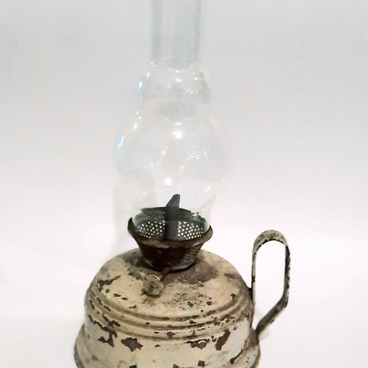In 1930, the Soviet revolutionary Sergo OrdzhonikIdze was appointed Chairman of the Supreme Council of National Economy and People’s Commissar of Heavy Industry. Among other things, his area of responsibility also included the oil and gas sector of Ishimbay. At the time, the sector was plagued with problems: the oil fields were causing gas pollution and the smell of hydrogen sulfide, and entire villages were flooded with oil gushers, forcing their residents to look for a new place to live.
This photograph depicts one of the earthen oil containers that served as emergency structures for gathering oil from uncontrolled gushers. The problem of hydrocarbon pollution was also exacerbated by the transportation of oil in barrels and its rafting down the Belaya River to the large city of Sterlitamak, where it served as fuel for boiler houses. After the commissioning of the Ishimbaevo-Ufa railroad, local oil began to be transported in tank cars to Saratov, where it was processed at the refinery. With the launch of the Ishimbay Oil Refinery in 1936, as well as the commissioning of an oil pipeline to Ufa, the environmental and distribution problems were partially resolved.
Grigory Ordzhonikidze (better known by his party nickname “Sergo”) was born in a village in Georgia in 1886. At the age of 15, his family sent him to study at a medical assistant school in Tiflis, which he graduated in 1905. Around the same time, he was introduced to social democratic ideas and joined the local cell of the Russian Social Democratic Labor Party. From then on, his revolutionary path repeated the fate of almost all of his future associates: from emigration and acquaintance with Vladimir Lenin to imprisonment and exile in Yakutia. There, he served as a medical assistant and performed his medical duties, while also continuing his party work.
He returned to Petersburg in June 1917. Same as his associates, Ordzhonikidze took an active part in organizing the October Revolution. In the early 1920s, Sergo settled down in the Caucasus, becoming the leading Bolshevik in the region. He played a key role in overthrowing the independent governments of Azerbaijan, Armenia, and Georgia, as well as uniting them into the Transcaucasian Federation. In 1926, Ordzhonikidze was accepted into the uppermost echelons of party and state power structures. His passion and activeness were key to successful industrialization, which is why it was not long until he became the People’s Commissar of Heavy Industry.
During the last years of his life, Ordzhonikidze, a close friend of Joseph Stalin, disagreed with the Soviet leader with ever-increasing frequency and openly criticized the repression. In 1936, he felt dark clouds gathering around him too: his brother Papuliya was arrested on the day of Sergo’s 50th birthday. Five days before the start of the 1937 February–March Plenum of the Central Committee of the All-Union Communist Party, which practically legitimized the Great Purge, Ordzhonikidze was found dead at his home. According to the official line, he died from a heart attack, however, according to a number of historians, he committed suicide.
This photograph depicts one of the earthen oil containers that served as emergency structures for gathering oil from uncontrolled gushers. The problem of hydrocarbon pollution was also exacerbated by the transportation of oil in barrels and its rafting down the Belaya River to the large city of Sterlitamak, where it served as fuel for boiler houses. After the commissioning of the Ishimbaevo-Ufa railroad, local oil began to be transported in tank cars to Saratov, where it was processed at the refinery. With the launch of the Ishimbay Oil Refinery in 1936, as well as the commissioning of an oil pipeline to Ufa, the environmental and distribution problems were partially resolved.
Grigory Ordzhonikidze (better known by his party nickname “Sergo”) was born in a village in Georgia in 1886. At the age of 15, his family sent him to study at a medical assistant school in Tiflis, which he graduated in 1905. Around the same time, he was introduced to social democratic ideas and joined the local cell of the Russian Social Democratic Labor Party. From then on, his revolutionary path repeated the fate of almost all of his future associates: from emigration and acquaintance with Vladimir Lenin to imprisonment and exile in Yakutia. There, he served as a medical assistant and performed his medical duties, while also continuing his party work.
He returned to Petersburg in June 1917. Same as his associates, Ordzhonikidze took an active part in organizing the October Revolution. In the early 1920s, Sergo settled down in the Caucasus, becoming the leading Bolshevik in the region. He played a key role in overthrowing the independent governments of Azerbaijan, Armenia, and Georgia, as well as uniting them into the Transcaucasian Federation. In 1926, Ordzhonikidze was accepted into the uppermost echelons of party and state power structures. His passion and activeness were key to successful industrialization, which is why it was not long until he became the People’s Commissar of Heavy Industry.
During the last years of his life, Ordzhonikidze, a close friend of Joseph Stalin, disagreed with the Soviet leader with ever-increasing frequency and openly criticized the repression. In 1936, he felt dark clouds gathering around him too: his brother Papuliya was arrested on the day of Sergo’s 50th birthday. Five days before the start of the 1937 February–March Plenum of the Central Committee of the All-Union Communist Party, which practically legitimized the Great Purge, Ordzhonikidze was found dead at his home. According to the official line, he died from a heart attack, however, according to a number of historians, he committed suicide.



